| Mellor Old Vicarage Dig - Open Days 1999 |
Until recently it had been thought that the Marple and District area was largely unaffected by the Roman occupation of Britain. There is now growing evidence that this was not the case, with a fascinating discovery at Mellor Old Vicarage that looks set to rewrite local history books.
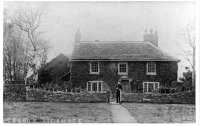 During
the summer of 1998 in the garden of the Old Vicarage owned by local historian Ann Hearle
and her husband John and in the adjacent field of Knowle Farm owned by Peter Hodgson, an
excavation was undertaken by Manchester University Archaeological Unit. The dig was
carried out because photographs taken by Ann and John showed unusual patterns that had
appeared on their lawn and in the field below the back of the house during the drought of
1995. They thought that these green and yellow lines and patches might indicate the
location of foundations of some mediaeval buildings.
During
the summer of 1998 in the garden of the Old Vicarage owned by local historian Ann Hearle
and her husband John and in the adjacent field of Knowle Farm owned by Peter Hodgson, an
excavation was undertaken by Manchester University Archaeological Unit. The dig was
carried out because photographs taken by Ann and John showed unusual patterns that had
appeared on their lawn and in the field below the back of the house during the drought of
1995. They thought that these green and yellow lines and patches might indicate the
location of foundations of some mediaeval buildings.
In the autumn of 1997 Peter Arrowsmith, author of the book Stockport, A History, visited Ann. He examined the photographs and
took a walk around the hill top. His conclusion was that there may have been a very early
occupation of the site. 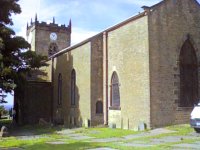 In the spring of
1998, his colleague, Graham Eyre-Morgan, visited Mellor and decided that a geographical
survey of the area should be undertaken. The results of this survey led to a team of
students from MUAU digging exploratory trenches in the Old Vicarage garden and a field of
Knowle Farm.
In the spring of
1998, his colleague, Graham Eyre-Morgan, visited Mellor and decided that a geographical
survey of the area should be undertaken. The results of this survey led to a team of
students from MUAU digging exploratory trenches in the Old Vicarage garden and a field of
Knowle Farm.
The first trench revealed not Anglo-Saxon burials, as had been postulated by Graham, but two post holes of unknown date. The second produced nothing of significance but the third and fourth trenches uncovered a defensive ditch, 4 metres wide and nearly 3 metres deep, cut through the earth and rock. A further excavation in the adjoining field exposed a continuation of the ditch. These results identified that a single ditched Iron Age Hill Fort had been discovered that once enclosed the sites of the Church, both old and new Vicarages and the Glebe Cottage, an area covering over five acres. This is the only hill-fort to have been found in the whole of the Greater Manchester area and consequently is a discovery of major archaeological significance.
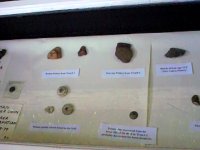 The scale of the find was 'mind boggling!' to the archaeologists. The number
of man hours involved in digging a ditch of such length and the building of the associated
rampart and palisade by the Celtic Brigantes tribe must have been a colossal undertaking.
There were vast quantities of Iron Age fire cracked pebbles and many pieces of Iron Age
pottery found, indicating a long occupation of the site from around 900 to 200 BC. Then,
much to the amazement of the team, finds of the Roman period were also made: pieces of pot
of late 1st and early 2nd centuries, pieces of roof tile and glass, a silver dinarius, c
78 AD, a lead door hinge and spinning whorls, a piece of quern and a lump of copper. It
seems that the Hill Fort may have been abandoned, probably around 100 BC and later,
reduced in size, used by the Romans as a small fort or signalling station.
The scale of the find was 'mind boggling!' to the archaeologists. The number
of man hours involved in digging a ditch of such length and the building of the associated
rampart and palisade by the Celtic Brigantes tribe must have been a colossal undertaking.
There were vast quantities of Iron Age fire cracked pebbles and many pieces of Iron Age
pottery found, indicating a long occupation of the site from around 900 to 200 BC. Then,
much to the amazement of the team, finds of the Roman period were also made: pieces of pot
of late 1st and early 2nd centuries, pieces of roof tile and glass, a silver dinarius, c
78 AD, a lead door hinge and spinning whorls, a piece of quern and a lump of copper. It
seems that the Hill Fort may have been abandoned, probably around 100 BC and later,
reduced in size, used by the Romans as a small fort or signalling station.
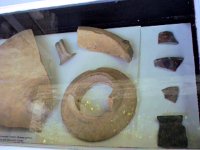 The
archaeologists returned in the summer of 1999. In the first three weeks
they removed the rest of the fill of the ditch and found the bottom at over two metres.
Amongst the many finds are over twenty shards of Iron Age pottery, along with one larger
piece that includes the lip of a vessel and a beautiful bronze disc that was part of the
decoration from the harness of a horse of the same period. Just when they thought there
could be no more surprises, they found several flints that have been dated to the late
Bronze Age, around 1200 BC.
The
archaeologists returned in the summer of 1999. In the first three weeks
they removed the rest of the fill of the ditch and found the bottom at over two metres.
Amongst the many finds are over twenty shards of Iron Age pottery, along with one larger
piece that includes the lip of a vessel and a beautiful bronze disc that was part of the
decoration from the harness of a horse of the same period. Just when they thought there
could be no more surprises, they found several flints that have been dated to the late
Bronze Age, around 1200 BC.
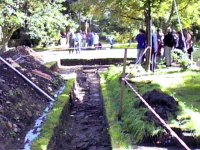 Work
then began on a new trench within the area of the fort. A dividing ditch, which they
thought the Romans may have dug, was not found but a large post hole was discovered. It
may have been part of the base of a defensive fence. They also found more than fifteen
Mesolithic flints from as long ago as 2500 to 8000 BC. The people from that very early
period would have been hunter / gatherers. At the other end of this trench an area of
'serious archaeology!' was reached. The working area was extended and within a short depth
there have been excavated finds of all periods, small ditches, upright (man placed) stones
and hearth areas. Work is continuing slowly and carefully, possibly to reveal an
Iron Age or Mesolithic dwelling.
Work
then began on a new trench within the area of the fort. A dividing ditch, which they
thought the Romans may have dug, was not found but a large post hole was discovered. It
may have been part of the base of a defensive fence. They also found more than fifteen
Mesolithic flints from as long ago as 2500 to 8000 BC. The people from that very early
period would have been hunter / gatherers. At the other end of this trench an area of
'serious archaeology!' was reached. The working area was extended and within a short depth
there have been excavated finds of all periods, small ditches, upright (man placed) stones
and hearth areas. Work is continuing slowly and carefully, possibly to reveal an
Iron Age or Mesolithic dwelling.
 On
Sunday 12th September 1999, following publicity in local papers and
coverage by a local TV news programme, the Old Vicarage was opened to the visiting public.
The event was blessed by excellent weather and very good attendance. Graham Eyre-Morgan
was on hand to answer questions and expound on likely scenarios on the site over the
enormous time span in question, along with other members of his MUAU team. The photographs
accompanying this article were taken during this open day.
On
Sunday 12th September 1999, following publicity in local papers and
coverage by a local TV news programme, the Old Vicarage was opened to the visiting public.
The event was blessed by excellent weather and very good attendance. Graham Eyre-Morgan
was on hand to answer questions and expound on likely scenarios on the site over the
enormous time span in question, along with other members of his MUAU team. The photographs
accompanying this article were taken during this open day.
Despite the wonderful discoveries made, only a small amount of the potential from this site has so far been uncovered. It is hoped that funds can be raised to enable the excavation work to continue each summer for a number of years to come, until the full story of the area around the church has been revealed. This site is the most important find in the North West of England and has already extended the known history of Stockport back several millennia.
John and Ann Hearle, who is Chairman of the Marple Local History Society, have set up 'The Mellor Archaeological Trust' to help fund the continuing work. If you would like to make a donation, or would like any further information about the Trust or the dig, please contact John and Ann at the Old Vicarage, Mellor, or by e-mail at contact Ann Hearle.
| Dig Index Page | |
| Open Days 1999 Report | |
| Open Days 2000 Update | |
| LHI Grant Awarded - April 2001 Press Release | |
| Mellor Well Dig Page 1 & Page 2 | |
| Open Days 2001 Update | |
| Newsletter July 2002 | |
| Open Days 2002 Update | |
| Open Days 2003 |